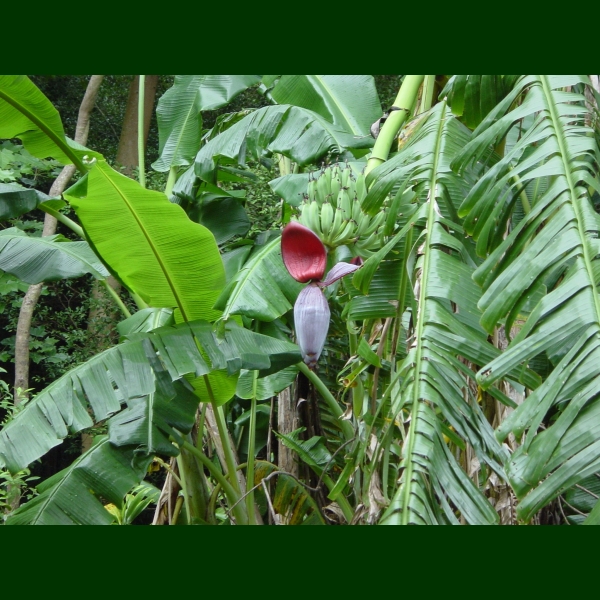 Hawaiian Name(s): mai‘a
Hawaiian Name(s): mai‘aScientific Name: Musa x paradisiaca
Vernacular Name: banana
Family: Musaceae
Status: Polynesian introduction
Authority: L.
Description: Oversized herb, 2-10 m tall, leaves 8-20 cm long.
Habitat A common cultivar that persits by vegetative reproduction in mesic to wet valleys and forests from 0–920 m, often near former habitation sites (Abbott 1992:37; Wagner et al. 1990:1464).
Medicines: There are numerous varieties of mai‘a (banana, Musa spp.) that have medicinal uses. These include the use of dried leaves, which are burnt and eaten with poi for intense heart burn. Also, this and hou nui o ke kino (profuse sweating) are treated with palaholo mai‘a, hau ke‘ake‘a bark, Palolo and ‘alaea clays, kō kea, kikawaioa leaf shoots (Christella cyatheoidea); this medicine is used in conjunction with ko‘oko‘olau and moa nahele tea. Forms of ‘ea, pa‘ao‘ao, pala, and ‘ukihi are treated with a medicine made of the sap of the flowers and pohuli (root sucker), mixed with sap from green kukui fruits (Aleurites moluccana) and he‘i (papaya, Carica papaya). Another variety of mai‘a is used to treat ‘ea and pa‘ao‘ao, this medicine uses the immature flowers and sheath, with ‘alaea clay, ‘ana (sponge, Leiodermatium spp.), and green kukui fruit. For treatment of lepo pa‘a (constipation), the fruit is combined with the fruits, flowers and flower leaf buds of kukui, the sap of hau ke‘ake‘a (Hibiscus tiliaceus), and ‘ohi‘a ‘ai bark (Syzygium malaccense), and kō kea (white sugarcane, Saccharum officinarum). This is cooked, strained, and drunk in conjunction with ko‘oko‘olau tea (Bidens spp.) and broiled koali leaf buds (Ipomoea spp.). For some types of kohepopo, ripe buds are combined with ‘uala huamoa (sweet potato variety, Ipomoea batatas), noni fruit (Morinda citrifolia), niu (coconut, Cocos nucifera), ko, and ‘alaea clay. Koali and ko‘oko‘olau tea with moa (Psilotum nudum) follow the treatment. Another variation for the treatment of kohepopo uses the sucker roots of the mai‘a with the bark of ‘uhaloa roots (Waltheria indica), ‘ohi‘a ‘ai and kukui bark, kohekohe (Eleocharis spp.), pōpolo (Solanum americanum), and kō kea. For bruises linked to ancestors, immature flowers are mixed with pōpolo, squid ink sack, and ‘alaea clay; again followed with koali and ko‘oko‘olau tea with moa. For anal itching associated with pinworms mai‘a fruit, koali vines, ‘uala mohihi, noni fruit, hau ke‘ake‘a and ‘ōhi‘a ‘ai bark, and ‘alaea clay and combined, strained and drunk. For forms of nae (shortness of breath) dried leaf ash and sap are used in conjunction with ‘ihi makole buds (Oxalis spp.), noni fruit, ‘ōhi‘a ‘ai bark, kukui endosperm and flowers, niu fruit, ‘ala‘alawainui pehu stems (Peperomia spp.), ‘alaea clay, and kō kea.The medicine is taken is combination with lu‘au, poi, and fish and a purgative tea of ko‘oko‘olau and moa nahele (Chun 1994:200–210).
Non Medicinal Uses: Nearly 20 varieties exist today falling into three major groups: maoli, popo'ulu and iholena. Mai‘a were not cultivated on a large scale. They were offered in the heiau and other houses of the gods. Three specific varieties were available for women to eat (popo'ulu, iholena and kaualau), the rest were forbidden (kapu). Certain varieties (polapola) steamed in an imu and pounded to make a type of poi. Used on hula altars (kuahu), the stalk symbolized a man. Stalks used to line the imu, as canoe rollers or used as a poultice. Fibers of leaves used in lei making. Sap used as a dye, and nectar from flowers used to feed babies. Understood as a kinolau or bodyform of the god Kanaloa, thus a set of kapu surrounded mai'a plants (see Abbott 1992:37–39, Handy et al. 1972:155–167) Leaf sheath beaten for kapa or used for sandals but both of poor quality (Lucas 1982: 18).
Specific gravity of wood: n/a
Famous Locations:
Mele:
`Ōlelo Noeau:
Dye Color and Parts: Sap
Kino lau: KANALOA.
Location on Bishop Museum Kalihi Campus:
Propagation Information:
